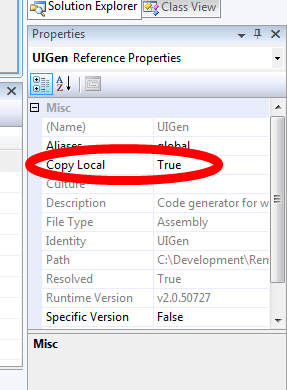
As the PhoneBook tutorial explains, uigen.exe is a fairly robust tool as soon as you got the configuration and the setup right. uigen.exe is picky in that
uigen.exe works for your project, you have to edit the uigen.exe configuration file to make it work for a different directory. This can bite you if you don't know this and try to duplicate a successful generation for a web project on a different disk or in a different directory.uigen.exe will complain that it can't load the domain assembly(s)The following instruction assumes the canonical project structure, as demonstrated with the PhoneBook project structure. We also assume that the re-motion assemblys are located in a sub-directory of the project root (as explained in in PhoneBook project structure).
uigen.exe data comes from several sources:
TabbedEditor.xml, but this is under the hood for the purpose of common uigen.exe tasks.)With all this considered, the invocation for the PhoneBook project looks like this:
PhoneBook.Domain\bin\Debug\uigen.exe /uigen:PhoneBook.xml /asmdir:Phonebook.Domain\bin\Debug |
Before you can invoke it, however, some preparations are required.
uigen.exe must load re-motion assemblys for reasons:
uigen.exe needsThe simplest trick is to leave all the hard work to Visual Studio and do the following:
uigen.exe in your domain project, i.e. make the uigen.exe executable part of the ensemble of referenced re-motion assemblys. For the PhoneBook.Domain project this looks like this:
Make sure you have "Copy Local" set to TRUE, otherwise Visual Studio won't fix the dependencies for you:

DONT FORGET TO REBUILD YOUR REBUILD YOUR DOMAIN PROJECT
The uigen.exe configuration file is an XML file and contains mainly "placeholders" for expanding all the project templates. Not all of them are relevant for your project, some are "legacy placeholders". The configuration file is an XML file and has two major nodes:
<settings> – paths needed by uigen.exe to find its template files and resources<placeholders> – that's your configurationA complete discussion of the configuration file can be found here: uigen.exe configuration file. A sample configuration file can be found here: sample uigen.exe configuration file.
The canonical place for the uigen.exe configuration file is the solution root, i.e. above all your Visual Studio sub-projects. By convention, it has the same name as the entire project. For the PhoneBook project that's PhoneBook.xml.
uigen.exeFor the PhoneBook project, the invocation looks like this. In the solution root, invoke
PhoneBook.Domain\bin\debug\uigen.exe /uigen:phonebook.xml /asmdir:phonebook.domain\bin\debug |
Again, this assumes that
uigen.exe executable has been copied to the domain project's bin\Debug (or bin\Release directory by Visual Studio (as explained in/uigen: switch specifies the name of the uigen.exe configuration file./asmdir: switch specifies the directory where the domain assemblys can be found. (This is inconsistent with dbschema.exe's /baseDirectory: switch, but it has the same meaning.)